As an Amazon Associate KitchenwareSets.com earns from qualifying purchases.
7 Zen Japanese Kitchen Countertops Ideas You Need To Try
Is your kitchen a source of stress instead of serenity? If you dream of swapping chaotic countertops and visual clutter for a space that feels calm, clean, and connected to nature, you’re not alone. Many homeowners find that the heart of their home has become a hub of noise and disorganization, a far cry from the peaceful sanctuary they desire. The constant battle with clutter can make cooking feel like a chore rather than a joy.
This is where the timeless wisdom of Japanese design comes in. It’s more than just an aesthetic; it’s a philosophy centered on minimalism, functionality, and harmony. By focusing on a few key elements, you can transform your kitchen from a place of chaos into a Zen-inspired retreat. As a design strategist who has guided countless homeowners, I know the countertop is more than a surface—it’s the heart of a kitchen’s aesthetic. We’ve distilled the essence of Japanese design into these core ideas.
A Zen Japanese kitchen countertop is the foundation for a calm, minimalist space. It focuses on natural materials like wood and stone, neutral colors, and matte finishes to create a serene, uncluttered environment that blends beauty with everyday functionality. We’re about to show you exactly how to achieve this look with 7 inspiring and actionable ideas.
Dreaming of a Serene Kitchen? Here’s How to Achieve Zen with Japanese Design
The frantic pace of modern life has us all searching for tranquility, and there’s no better place to cultivate it than in the heart of your home. A Japanese-inspired kitchen offers an escape, turning a purely functional room into a restorative sanctuary. This design philosophy is built on the idea that your environment should bring you a sense of peace and connection. The journey to this serene space begins with the largest, most impactful surface: your countertop.
What is a Japanese Style Kitchen?
A Japanese-style kitchen prioritizes minimalism, natural materials, and functionality. It’s a space designed to be as calming to the soul as it is efficient for the cook. Key elements include uncluttered surfaces, wood and stone features, a neutral color palette, and clever storage solutions to create a serene and harmonious space that connects the user with nature. This aesthetic often overlaps with Scandinavian design, creating the popular “Japandi” style.
- Natural Materials: Wood, stone, and bamboo are central, bringing the outside in.
- Minimalism & Lack of Clutter: Every item has a purpose and a place. Countertops are kept clear to create a sense of openness.
- Functionality: Smart, hidden storage is key. Cabinets are often handleless to maintain clean, seamless lines.
- Neutral Color Palette: The look is built on warm, muted tones like beige, sand, cream, and soft grays, creating a light and airy feel.
- Connection to Nature: Large windows, natural light, and the inclusion of plants are essential for blurring the line between indoors and out.
7 Zen Japanese Kitchen Countertops Ideas You Need To Try in 2025
The countertop is the soul of your Zen kitchen. It sets the tone for the entire room, influencing everything from light and texture to the overall feeling of calm. Forget fleeting trends; these 7 ideas are rooted in timeless Japanese design principles, updated for modern living. Curated from top interior designers and successful Japandi kitchen renovations, each concept balances enduring beauty with everyday practicality, providing a solid foundation for your serene culinary space.
1. Embrace Natural Stone for Enduring Tranquility
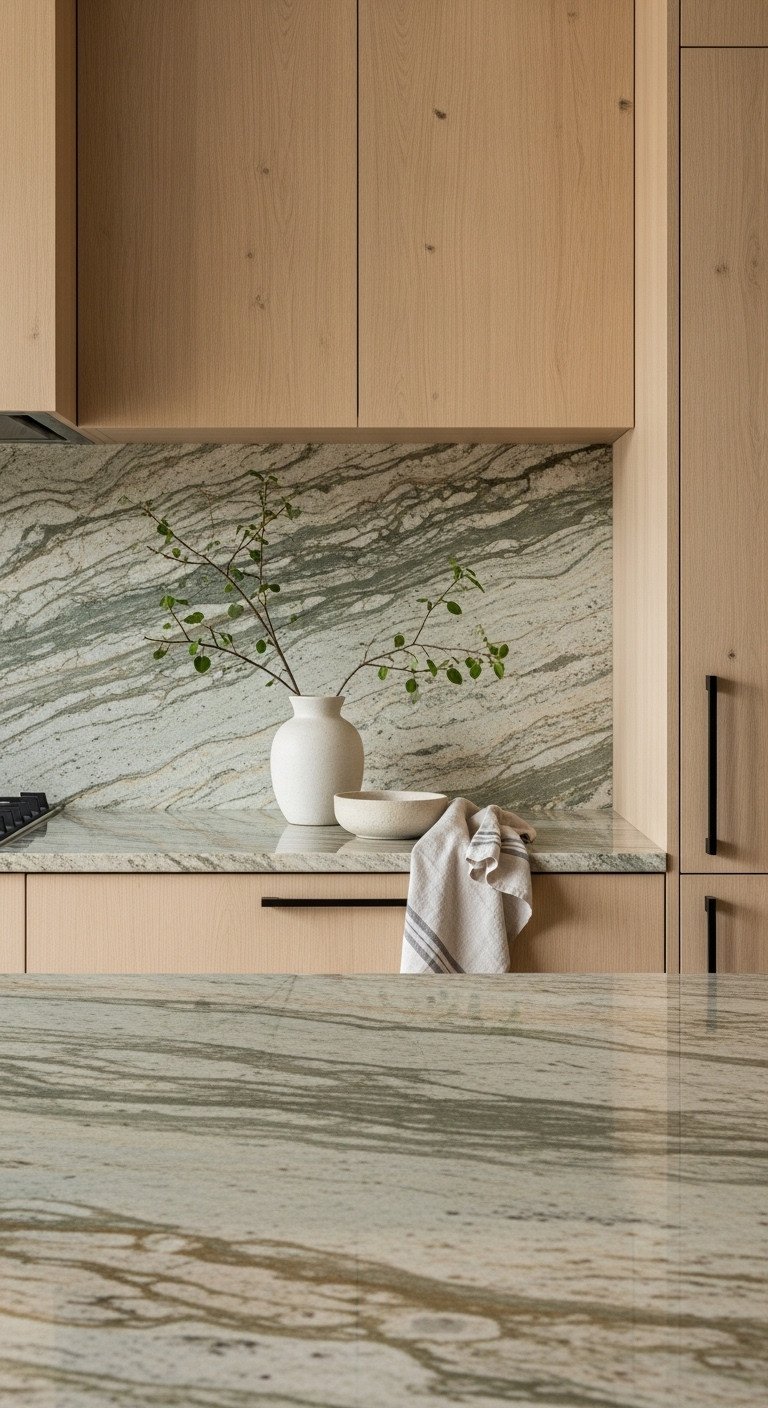
Save this tranquil stone idea to your “Japandi Kitchen” board!
Natural stone countertops like granite, quartzite, or limestone are the perfect choice for a Japanese kitchen because they are both beautiful and practical. Their durability withstands daily wear while their earthy, muted tones and subtle patterns connect the space directly to nature, creating a foundation of calm.
Materials Needed:
* Countertop material samples (Granite, Quartz, Marble)
* Cabinet door sample
* Paint swatches for your kitchen walls
Step-by-Step Directions:
1. Source Samples: Order samples of stones in muted, earthy tones. Look for green, beige, or soft gray granite and quartzite with minimal, flowing patterns rather than busy speckles.
2. Test in Your Light: Place the samples in your kitchen. Observe how they look in the morning, afternoon, and evening light. The goal is a soft, natural appearance, not a high-gloss reflection.
3. Prioritize a Matte Finish: When ordering, specify a honed or leathered finish instead of polished. A high-quality stone sealer designed for matte finishes is essential to protect the surface from stains without adding shine.
4. Pair with Cabinetry: Hold your samples against your cabinet door. For a classic Japandi look, pair a soft gray stone with light oak cabinets or a beige stone with white cabinets.
Pro-Tip: While marble is beautiful, it’s softer and more porous. For a durable, low-maintenance alternative with a similar aesthetic, consider a high-quality quartzite. It offers the beauty of marble with the toughness of granite.
2. Incorporate Warm Wood for a Natural Connection
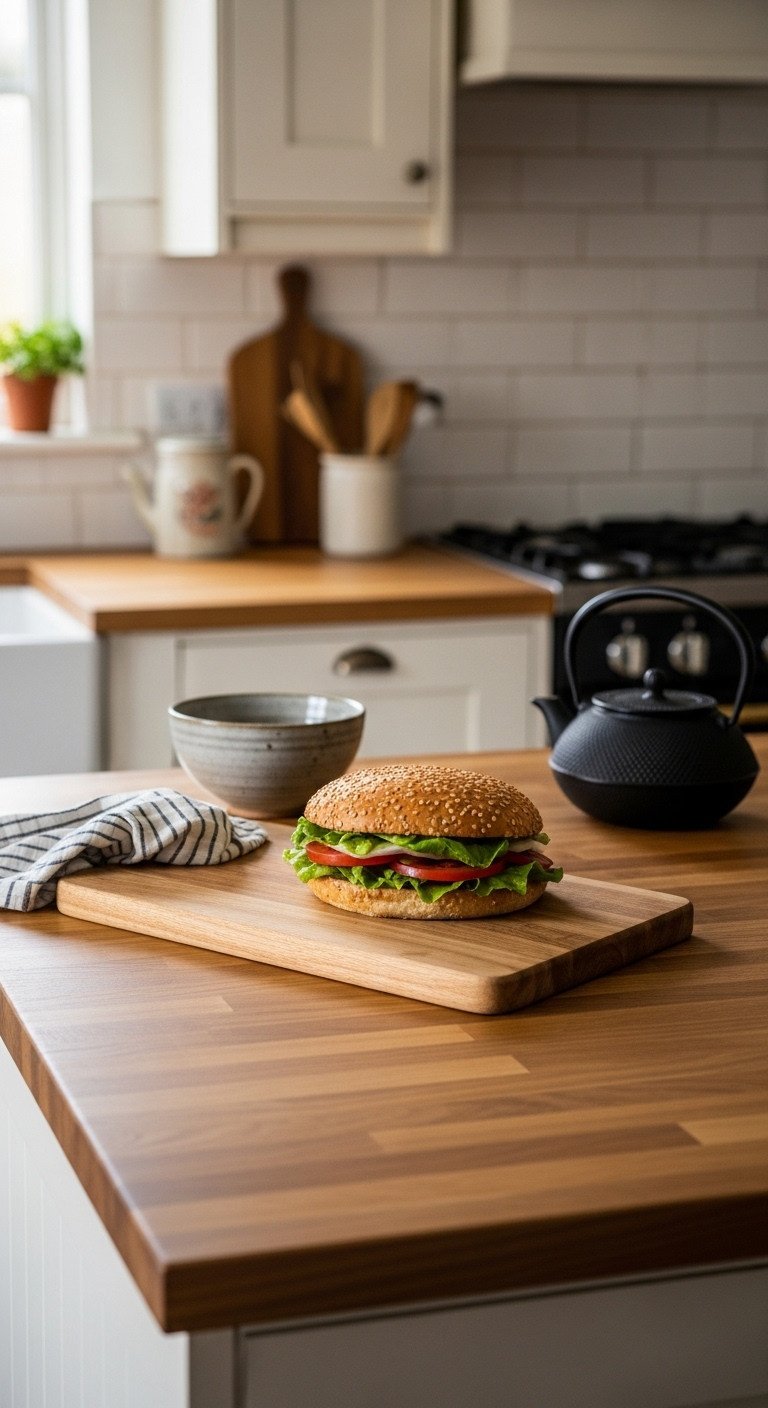
Pin this warm wood inspiration for your future kitchen!
Finely crafted wood countertops, especially butcher block style, are a cornerstone of Japanese and Japandi design. Using light-toned woods like oak or pine introduces a soft, warm, and inviting element that instantly connects the kitchen to the natural world.
Materials Needed:
* Butcher block countertop (e.g., Oak, Pine, Walnut)
* Fine-grit sandpaper (220-grit)
* Food-safe wood oil or conditioner
* Clean, lint-free cloths
Step-by-Step Directions:
1. Select Your Wood: Choose a light-toned wood like oak or pine for a Scandinavian feel, or a slightly richer American walnut for a deeper, more traditional Japanese look.
2. Prepare the Surface: If unfinished, lightly sand the countertop with 220-grit sandpaper, moving in the direction of the grain. Wipe away all dust with a clean cloth.
3. Apply a Protective Finish: The key to a long-lasting wood countertop is the finish. Generously apply a high-quality, food-grade mineral oil or butcher block conditioner with a cloth. This type of finish penetrates the wood, protecting it from within while maintaining a natural, matte look.
4. Allow it to Absorb: Let the oil soak in for at least 30 minutes (or as directed by the product), then wipe away any excess.
5. Reapply Regularly: Maintain the protective barrier by re-oiling the countertop every month to keep it from drying out and repelling water.
Pro-Tip: Don’t be afraid of minor scratches or dents that may occur over time. This aligns with the wabi-sabi philosophy of finding beauty in imperfection and the history of a well-loved space.
3. Opt for Minimalist Concrete for a Modern Edge
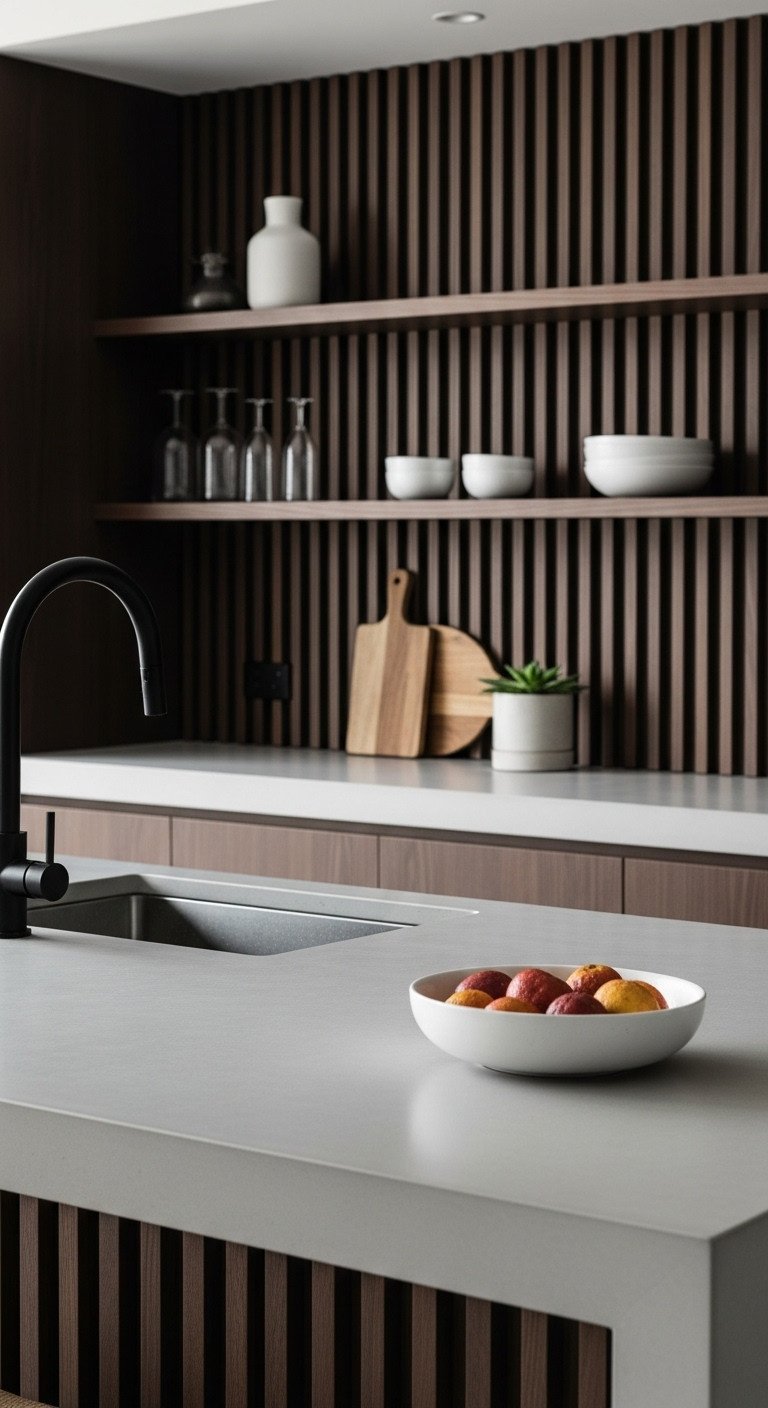
Love modern minimalism? Save this concrete countertop idea!
Sleek concrete countertops offer a modern, minimalist alternative that pairs beautifully with the organic elements of Japandi design. Its subtle texture and neutral gray tones provide an industrial edge that contrasts perfectly with warm woods and soft textiles, creating a balanced and contemporary space.
Materials Needed:
* Concrete countertop mix
* Melamine for building the mold
* Reinforcing mesh
* Concrete sealer
* Orbital sander with various grit pads
Step-by-Step Directions:
1. Consider Professional vs. DIY: While professional installation is recommended for a perfect finish, you can achieve a rustic look with a DIY approach. A complete DIY concrete countertop kit often includes the mix, forms, and basic tools to simplify the process.
2. Build Your Mold: Create a precise mold of your countertops using melamine boards, ensuring all seams are sealed with silicone.
3. Mix and Pour: Mix the concrete according to the product’s instructions and pour it evenly into the mold, vibrating the mold to remove air bubbles.
4. Cure and Demold: Allow the concrete to cure for the recommended time (several days). Once cured, carefully remove the mold.
5. Sand and Seal: Sand the surface to your desired smoothness, starting with a coarse grit and moving to a fine grit. The most crucial step is applying several coats of a high-quality, food-safe concrete sealer to prevent staining and etching.
Lesson Learned: The color of your sand and aggregate will affect the final color of the concrete. For a consistent, light gray Japandi look, use white sand and a high-quality white Portland cement mix.
4. Choose a Matte Finish for Understated Serenity
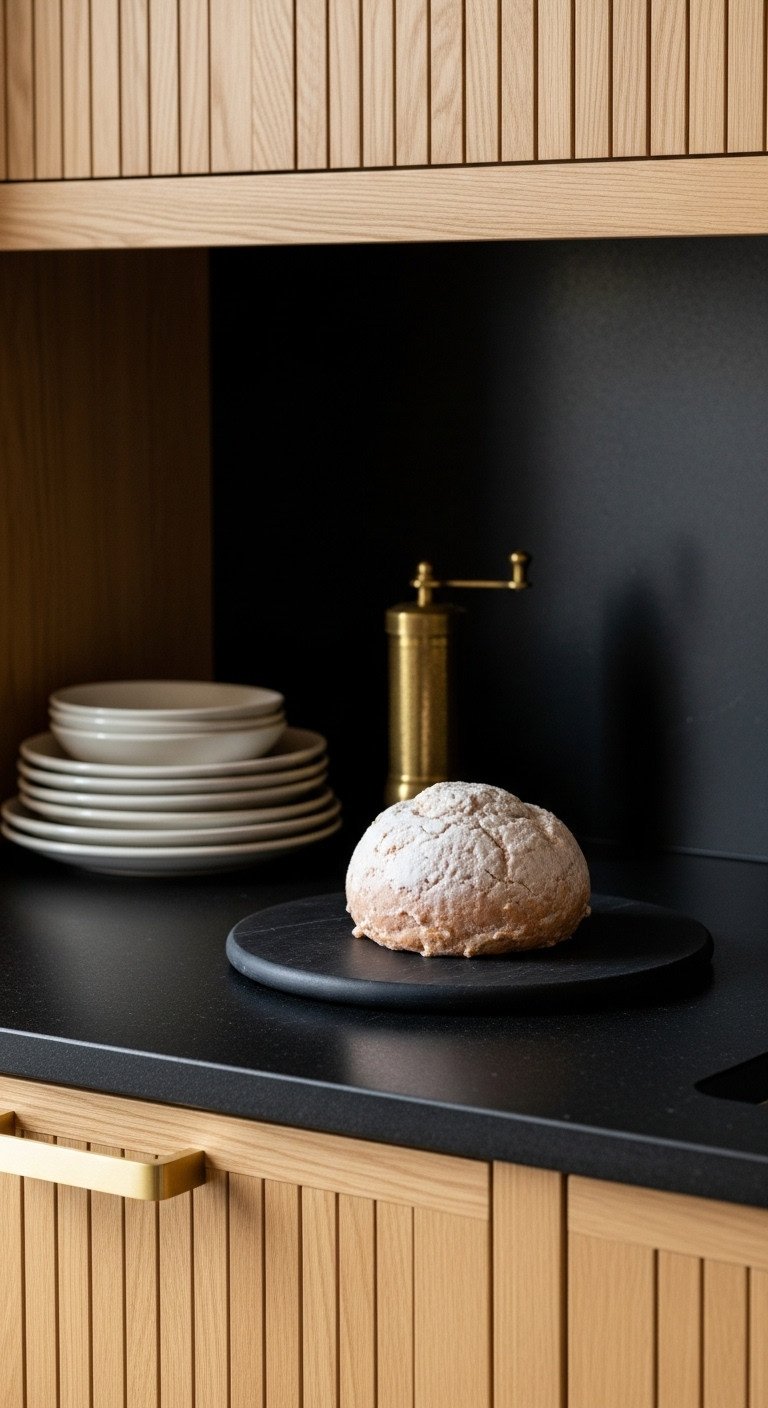
Add this sophisticated matte finish to your design board!
A non-reflective matte finish is essential for achieving a truly serene kitchen atmosphere. Unlike polished surfaces that create harsh glare, a honed, leathered, or matte finish on stone or quartz absorbs light, resulting in a soft, understated look that reduces visual noise and promotes a sense of calm.
Materials Needed:
* Countertop samples in both polished and matte/honed finishes
* Microfiber cloth
* pH-neutral stone cleaner
Step-by-Step Directions:
1. Request Matte Samples: When sourcing stone or quartz, specifically ask for “honed,” “leathered,” or “matte” finish samples. Compare them side-by-side with their polished counterparts.
2. Observe the Light: Notice how the matte samples absorb light rather than reflecting it. This single characteristic reduces visual noise and creates a much calmer feeling in the room.
3. Consider Maintenance: Matte finishes can be more susceptible to showing fingerprints or oil marks than some polished surfaces. Plan to clean them with a pH-neutral cleaner. For existing surfaces you wish to change, a professional can hone them, but for porous materials, applying a high-quality topical matte countertop finish can offer protection and the desired look.
4. Commit to the Aesthetic: A matte finish is a commitment to the soft, understated look of Japandi design. It pairs beautifully with natural wood textures and simple, clean lines.
Pro-Tip: Soapstone is a naturally matte material that is a fantastic choice for Japandi kitchens. It develops a beautiful patina over time, perfectly embodying the wabi-sabi spirit.
5. Master the Art of the Clean & Uncluttered Countertop
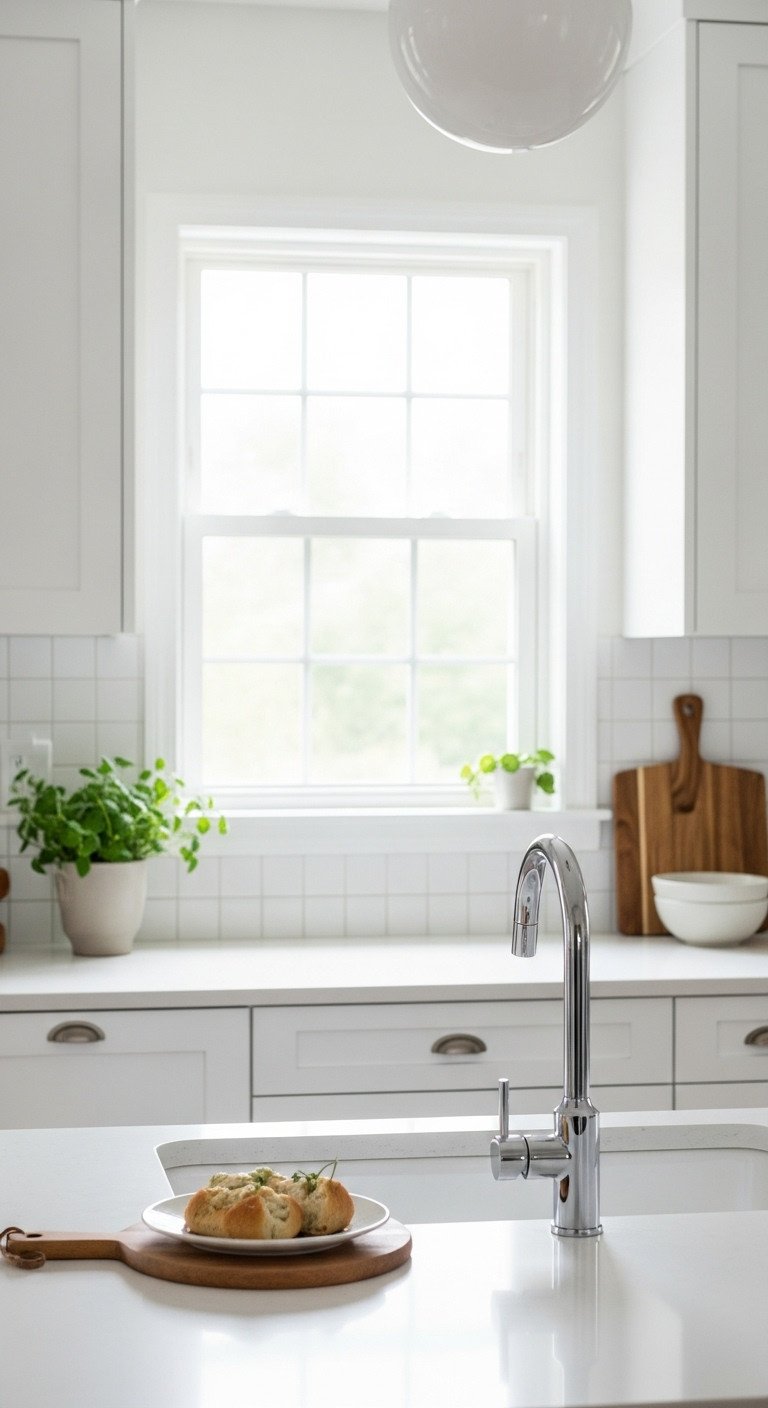
Save this to remember the power of minimalist design!
This “idea” is a core principle: the most beautiful Japanese countertop is a clean one. The aesthetic is defined by a lack of clutter, which allows the natural beauty of the materials to take center stage. Achieving this look requires intentional and clever storage solutions.
Materials Needed:
* Drawer organizers
* Appliance garage or cabinet
* Wall-mounted magnetic knife strip
* Minimalist storage solutions
Step-by-Step Directions:
1. Design for Hidden Storage: The easiest way to keep counters clear is to plan for storage from the start. Opt for deep drawers, pull-out pantries, and handleless cabinets to maintain a seamless look.
2. Create an “Appliance Garage”: Designate a specific cabinet or a corner cabinet with a door to hide items like the toaster, blender, and coffee maker.
3. Go Vertical or Hidden: Instead of a knife block on the counter, install a wall-mounted magnetic strip or a drawer-insert knife block.
4. Curate What Stays: The goal isn’t a completely empty counter, but an intentionally styled one. Keep only 1-3 beautiful and functional items out, such as a beautiful cutting board, a ceramic utensil crock, or a small plant. For items like cooking oils and salt, a sleek countertop tray or organizer box can consolidate them into a single, tidy visual element.
Pro-Tip: Before a renovation, perform a “countertop audit.” For one week, place every item you use back in a cabinet or drawer immediately after use. You’ll quickly see what you truly need accessible versus what is just creating clutter.
6. Add Depth with Wabi-Sabi Stone Textures
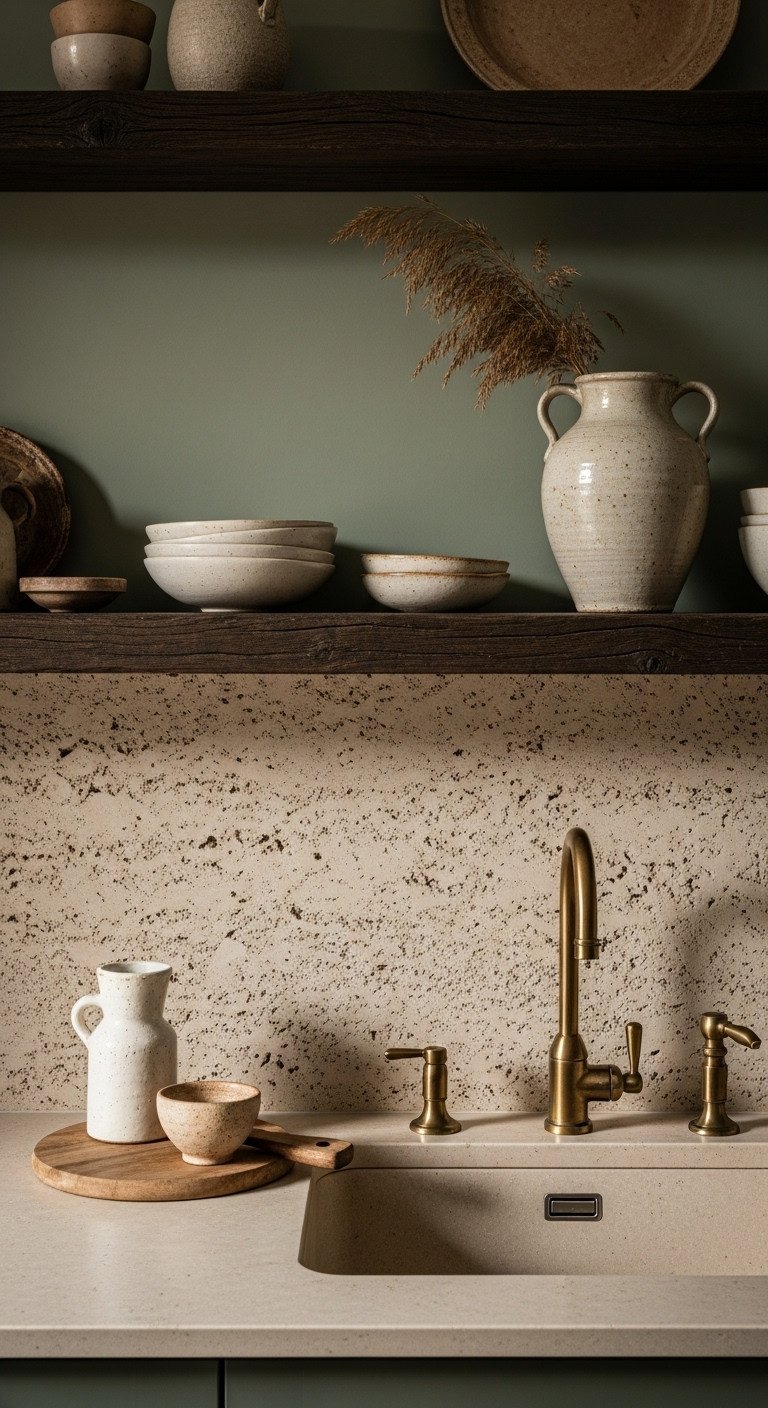
Pin this beautiful textured look for a touch of wabi-sabi!
Adding natural, imperfect textures is key to the wabi-sabi philosophy, which finds beauty in the authentic and flawed. Instead of a perfectly uniform surface, consider a stone with a “leathered” finish or pair a smooth countertop with a textured stone backsplash to add organic depth and character.
Materials Needed:
* Textured material samples (honed/leathered stone, split-face tile)
* Smooth countertop sample
* Textured decor items
Step-by-Step Directions:
1. Contrast Smooth with Rough: The key to this look is balance. Pair a smooth, simple countertop (like beige quartz or light wood) with a more textured element nearby, such as a split-face stone tile backsplash.
2. Choose a “Leathered” Finish: For the countertop itself, ask for a “leathered” finish. This process gives stone a soft sheen and a pleasant, slightly pebbly texture that begs to be touched.
3. Incorporate Textured Accessories: The easiest way to add texture is through accessories. Instead of a polished container for utensils, choose a heavy, carved natural stone utensil crock. This small touch adds organic weight and character.
4. Embrace Natural Flaws: When selecting wood or stone, look for pieces with natural imperfections—subtle cracks, interesting mineral deposits, or unique grain patterns. This is the essence of wabi-sabi.
Pro-Tip: Don’t overdo it. In a minimalist design, one strong textural element is enough to make a statement. Let the textured stone backsplash or the leathered countertop be the star, and keep other surfaces simple.
7. Harmonize with a Neutral Color Palette
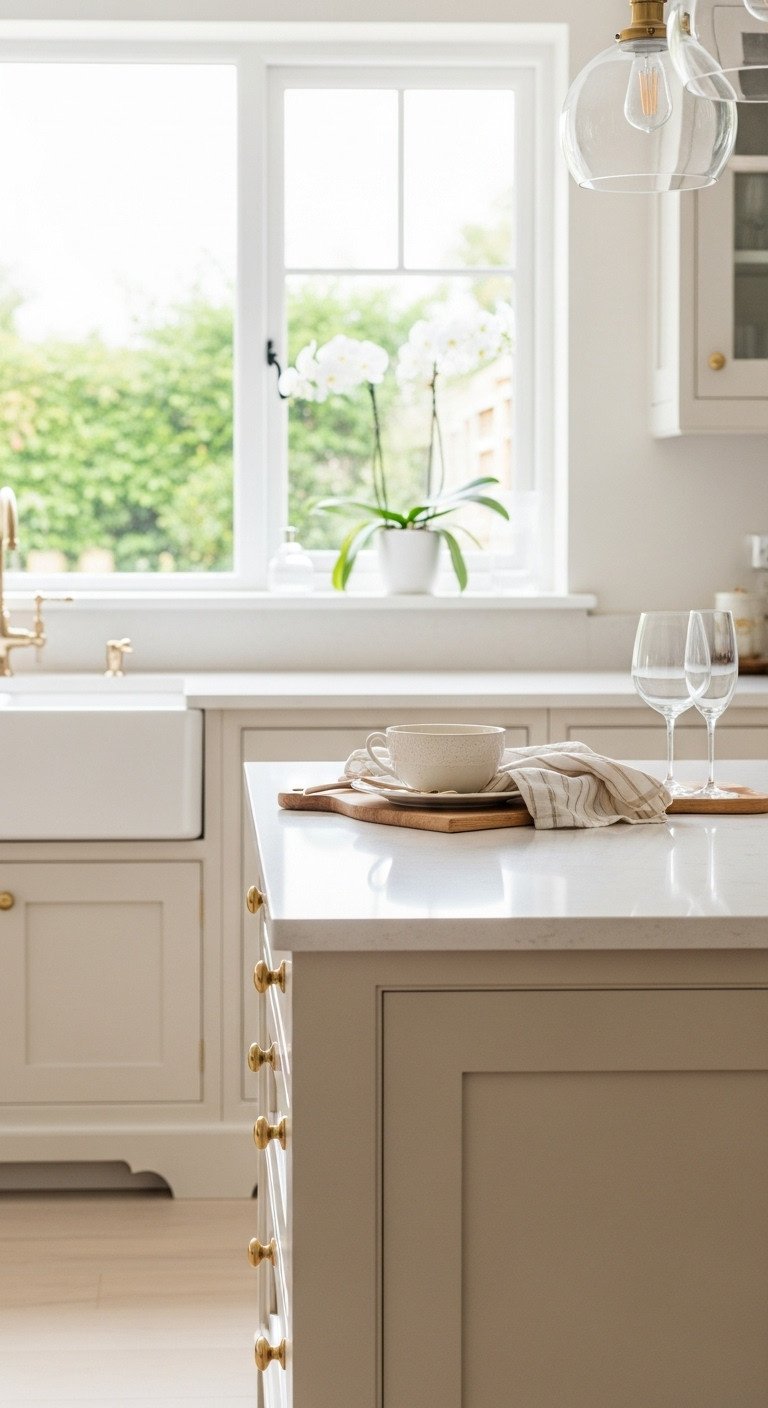
Save this calming color palette for your dream kitchen!
A harmonious, neutral color palette is the backdrop for a tranquil Japandi kitchen. Countertops in warm, muted tones such as sand, beige, cream, or soft gray create a seamless and calming visual flow. These earthy shades connect the space to nature and promote a light, welcoming atmosphere.
Materials Needed:
* Paint swatches in your chosen neutral palette
* Cabinet sample
* Flooring sample
* Multiple countertop material samples
Step-by-Step Directions:
1. Gather Your Palette: Collect samples of all your other kitchen finishes—cabinets, floors, and wall colors. Your palette should be dominated by warm, muted tones.
2. Order a Range of Samples: Don’t just get one white or one beige countertop sample. Get several with slightly different undertones (e.g., a pinkish-beige, a yellowish-cream, a cool gray). A quartz countertop sample kit with multiple neutral tones is an excellent way to see a variety of options at once.
3. Create a Mood Board: Lay all your samples together on a board. This allows you to see how the countertop color interacts with everything else. You’re aiming for harmony, not necessarily a perfect match.
4. Consider a Subtle Contrast: For a true Japandi look, consider pairing a light wood cabinet with a soft white or cream countertop. Alternatively, for a more dramatic Japanese feel, use a light countertop with darker wood cabinets or add black accents through hardware or fixtures.
Pro-Tip: Pay close attention to undertones. A creamy white countertop can look yellow next to a cool gray cabinet. Viewing your samples together in your kitchen’s natural light is the most important step to getting the color right.
Key Takeaways: Your Quick Guide to Japanese Kitchen Countertops
- Prioritize Natural Materials: Wood (oak, walnut) and Stone (granite, quartzite) are the cornerstones of the aesthetic, connecting your kitchen to nature.
- Choose Matte Over Glossy: A honed, leathered, or matte finish reduces glare and creates a softer, more serene atmosphere.
- Stick to a Neutral Palette: Build your design around warm, muted tones like beige, cream, sand, and soft grays for a calming effect.
- Embrace Minimalism: The most beautiful countertop is an uncluttered one. Design for hidden storage to let the material shine.
- Texture is Key: Add depth and character through the natural textures of wood grain or the imperfect beauty of honed stone, aligning with the wabi-sabi philosophy.
People Also Ask About Japanese Kitchen Countertops
What is the best countertop for a Japandi kitchen?
The best countertops for a Japandi kitchen blend natural beauty with durability. Light wood butcher block (like oak) is excellent for warmth, while stone options like quartzite, honed granite, or limestone in muted, earthy tones offer resilience and a serene aesthetic. The key is choosing a natural material with a matte or honed finish to maintain a soft, minimalist look.
What colors work in Japandi kitchens?
Japandi kitchens thrive on a neutral, muted color palette. Base colors include sand, beige, cream, stone, and soft grays. You can introduce gentle contrast with light Scandinavian shades like pale blue or add depth with darker Japanese-inspired earthy tones like charcoal, indigo, or rich browns. The goal is to create a calm, harmonious, and light-filled space.
How do I make my kitchen look Japanese?
To make your kitchen look Japanese, focus on minimalism, natural materials, and functionality. Start by decluttering your countertops completely. Incorporate natural wood elements in cabinets or countertops. Choose a neutral color scheme and simple, clean lines. Opt for hidden storage and handleless cabinets to maintain a sleek, uncluttered appearance that promotes a sense of calm.
Final Thoughts
Transforming your kitchen into a Zen-inspired sanctuary is more than a renovation project; it’s an investment in your daily peace of mind. Your kitchen can be more than just a room for cooking—it can be a place to breathe, to connect, and to find calm in a busy world. You don’t have to do everything at once. Start by choosing the one element that will make the biggest impact: the perfect countertop. It’s the first and most important step toward creating the peaceful, beautiful space you deserve.
Which of these countertop ideas inspires you the most? Share your favorite in the comments below
Last update on 2025-10-14 at 22:50 / Affiliate links / Images from Amazon Product Advertising API
